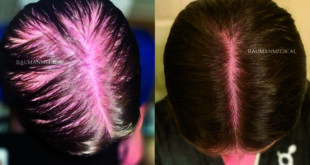By Alan J. Bauman, M.D. –
 SOUND FAMILIAR?
SOUND FAMILIAR?
A woman with a once lush mane finds herself spending more time camouflaging the thinning areas on her scalp…
A man in his prime sees the telltale recession of his hairline or some premature thinning of his crown…
Both of them see a reflection in the mirror that looks older than they feel.
What’s next? Thanks to recent advances in hair loss diagnosis, medical treatments, scientific hair growth tracking and hair restoration procedures, men and women who want to maintain, enhance or restore their hair now have many viable alternatives at their disposal.
The key is finding a knowledgeable and compassionate medical specialist who can help guide them to their goals.
By the time you’ve noticed some thinning, you’ve already lost up to 50 percent of the hair in that area. It’s therefore critical to get immediate help to address the loss at the earliest possible stage.
STEP #1: Seek a consultation.
Should you ask your friend, a hairstylist, your family doctor or dermatologist? The first crucial step in protecting or restoring your hair is to visit with a doctor who specializes exclusively in hair loss—an experienced, full-time board-certified Hair Restoration Physician.
During a one-on-one consultation with a hair loss specialist, you can learn about the causes of your hair loss and hair thinning. Non-invasive genetic hair loss testing, hair measurements and video-microscopic scalp analysis may be performed. You can also learn about the various effective medical strategies and develop a realistic results-oriented treatment plan to reach your goals.
If your treatment plan includes hair transplantation, you will learn how today’s advanced artistic microsurgical techniques comfortably restore hair in a way that is 100 percent undetectable and never ever “pluggy.” You may also learn that new minimally-invasive hair transplantation methods, like NeoGraft FUE, heals faster, more comfortably and leaves absolutely NO telltale linear scar.
STEP #2: Prevention requires effective multi-therapy treatments and tracking.
It’s important to realize that hair loss gets worse with time without treatment. If you start early enough, you can reduce the risk of needing extensive hair transplantation.
A well-rounded multi-therapy approach includes non-invasive therapies to protect the hair you have:
• Propecia/finasteride: FDA-approved prescription pills for men that safely halt further hair loss and/or moderately restores growth in 90% of patients.
• Low Level Laser therapy: At-home treatments with powerful, portable devices like LaserCap improve your hair without side effects and without having to travel to the clinic.
• Topical treatments: New topical prescription ‘Formula 82M’ minoxidil, has made over-the-counter Rogaine® nearly obsolete due to its ease of use and powerful results.
• Nutritionals: Beyond biotin, professional pharmaceutical-grade supplements support hair growth and improve hair quality from the inside out.
Stopping the progression of hair loss with non-invasive treatments is an important part of any hair restoration treatment plan.
Results Tracking: HairCheck™ scientific hair growth measurements at Bauman Medical Group allow us to monitor your hair loss or hair regrowth process with great accuracy in order to determine if your treatment regimen is achieving the desired results.
STEP #3: 100% undetectable, permanent hair transplants.
Should hair transplantation be recommended, healthy hair follicles from the back of the scalp are harvested individually and then transplanted into areas where thinning has occurred. Hair transplant surgery is a delicate procedure that requires not only a technically skilled surgical team but also an artistic eye on the part of the surgeon. Meticulous attention to detail and advanced, minimally invasive techniques can deliver a 100% natural result.
With safe local anesthesia, patients watch movies, eat lunch, listen to music or nap during the process that may take several hours. Along with new less-invasive surgical techniques like the no-scalpel, no-stitch “NeoGraft FUE,” patients can be assured that transplantation is a comfortable process that heals quickly with minimal interruption in their routine.
STEP #4: Appropriate expectations.
Your Hair Restoration Physician will clearly explain what is expected from the prescribed regimen of medical and/or surgical treatments. Within days the transplanted area is healed and hair growth begins in about two months. Visible changes can be appreciated in four to six months with a full result in about a year. Some patients may require more than one session to reach their hair restoration goals. And the best part is that the transplanted hair lives and grows permanently!
Alan J. Bauman, M.D.
Hair Restoration Physician
Dr. Alan J. Bauman is Founder and Medical Director of Bauman Medical Group in Boca Raton, Florida, an international practice specializing exclusively in the treatment of hair loss since 1997. Dr. Bauman is a one of a handful of surgeons worldwide who is a Diplomate of the American and International Board of Hair Restoration Surgery and also recommended by the American Hair Loss Association. A frequent lecturer and faculty member at major international medical conferences, his advanced hair restoration techniques and procedures have been featured on CNN, Dateline NBC, ABC’s Good Morning America, CBS Early Show, EXTRA, Access Hollywood as well as in Men’s Health Magazine, Allure, Redbook, Cosmo, Women’s Health, Vogue, W Magazine, USA Today, The New York Times and more. For more information on protecting, enhancing and restoring your own living and growing hair, call toll-free at 877-BAUMAN-9, or learn more online at www.baumanmedical.com
Check Also
Physical Therapy for the Brain
Have you noticed you have difficulty hearing your family and friends in a noisy restaurant? …
 South Florida Health and Wellness Magazine Health and Wellness Articles
South Florida Health and Wellness Magazine Health and Wellness Articles




